
What to bring on a liveaboard dive trip
Whether you’re a beginner diver just starting out, an advanced diver with loads of diving under your belt or a tech diver, a liveaboard scuba trip should be on your bucket list.
What to pack for a liveaboard dive trip:
- Travel documents.
- Travel money.
- Diving certification and log book.
- Toiletries.
- Clothes for the climate.
- Footwear.
- Swimsuit.
- Appropriate exposure suit.
- Underwater camera gear.
- Ear plugs.
- Medication including sea sickness tablets.
- Scuba diving equipment.
- Sun glasses.
- Book(s) or kindle.
The best way to do more diving is to book yourself on a scuba diving liveaboard. You can check the latest and best deals on liveaboards using the following window:
The essentials to pack for a liveaboard dive trip
Many divers who have dived on a liveaboard find it’s the only way to dive. Diving from a liveaboard means you’ll spend time with like-minded people for the duration of the trip.
Liveaboard diving provides the opportunity to dive sites that can’t be reached by resort day boats. The dive sites are less crowded and have less divers on them. You have more opportunity to do loads more dives over the course of your holiday vs resort diving.
But also you’ll get more chances to night dive on a liveaboard, depending on the location.
More Reading: Liveaboard Diving or Resort Diving (The Pros Versus The Cons Of Both)
With this in mind, what are the liveaboard essentials for any liveaboard dive trip?
More Reading: The best budget liveaboard dive boats Sea of Cortez
1. Travel documents

Without your travel documents you’re not going anywhere. This is especially true if the liveaboard you’re joining is overseas from where you live.
If you are going to another country, you’ll need your passport, usually with at least six months left to run before it expires. Also check to see if you need a visa. If you do, make sure you apply in plenty of time.
Make sure you take a least one debit card and one credit card. Preferably one card as a Visa card and the other as a MasterCard.
But before you leave, make contact with the card issuing bank and let them know your country of travel. This way they are less likely to block any transactions.
As you’re going to be traveling through an airport, you are better advised to buy a safe travel wallet with a RFID Blocking Function for Passports.
You will also need to make sure you have your flight details. These days you can use your mobile device to show Your boarding pass as you go through passport control and at the boarding gate.
More Reading: Where’s the best tech dive liveaboard destinations in the world?

Table of dive liveaboards
This list of liveaboards is in descending customer rating order, followed by Scuba Diving Luxury Rating (SDE Lux Rating, see below), so the liveaboards with the highest customer rating and the best SDE lux rating will be at the top of the list. If you want to change the list order, use the “Sort by” dropdown below.
| Discover Liveaboard | Customer Rating | SDE Lux Rating % | Flexible Booking | Dive Courses | Dietary Requirements | Nitrox | Country | |
|---|---|---|---|---|---|---|---|---|
 |
Review: MV Andromeda; Book: MV Andromeda | 10 | 65% | NO | YES | YES | YES | Egypt |
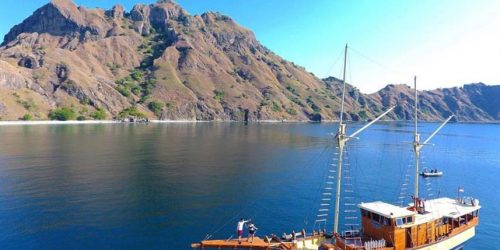 |
Review: Cahaya Bersama; Book: Cahaya Bersama | 10 | 63% | YES | YES | YES | NO | Indonesia |
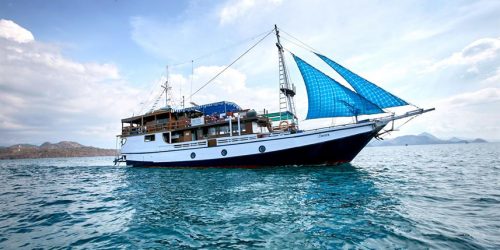 |
Review: MV Tarata; Book: MV Tarata | 10 | 52% | NO | NO | YES | YES | Indonesia |
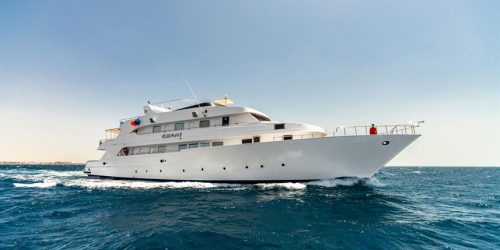 |
Review: MV Ghani; Book: MV Ghani | 10 | 50% | YES | YES | YES | YES | Egypt |
 |
Review: Wisesa; Book: Wisesa | 9.9 | 71% | YES | YES | YES | NO | Indonesia |
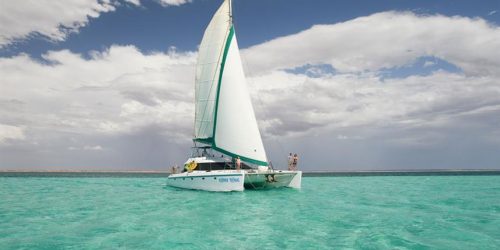 |
Review: Shore Thing Catamaran; Book: Shore Thing Catamaran | 9.9 | 69% | YES | YES | YES | NO | Australia |
 |
Review: MV Blue Manta; Book: MV Blue Manta | 9.9 | 69% | NO | YES | YES | YES | Indonesia |
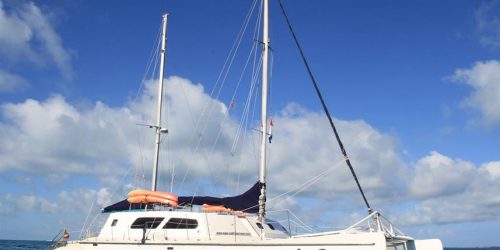 |
Review: Cat Ppalu; Book: Cat Ppalu | 9.9 | 50% | YES | YES | YES | NO | Bahamas |
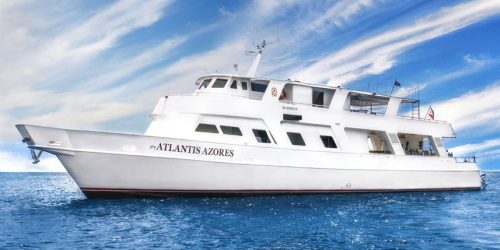 |
Review: MY Atlantis Azores; Book: MY Atlantis Azores | 9.8 | 87% | NO | YES | YES | YES | Philippines |
 |
Review: MV Ocean Hunter 3; Book: MV Ocean Hunter 3 | 9.8 | 73% | YES | NO | YES | YES | Micronesia |
The Scuba Diving Earth Luxury Rating (SDE Lux Rating) is explained on each liveaboard review when you click the “Discover Liveaboard” link, and is my own Liveaboard Luxury Rating I’ve assigned to all liveaboards. Choosing between liveaboards is helped by customer scores, and if you get stuck choosing between two or three liveaboards, where each one has a high customer score out of 10, you can use the SDE Luxury Rating to help narrow down your choice.
Think about it like using Booking.com when searching for the best hotel. Booking.com also use a customer score where each customer rates hotels out of 10. This is similar to the liveaboard customer rating, which is also rated out of 10. But let’s say you only like to stay in hotels rated 8 and above on Booking.com, but you also want the hotel to have WIFI or parking, or to have a swimming pool etc. The features each hotel has is usually secondary to the score out of 10.
2. Travel money and currency
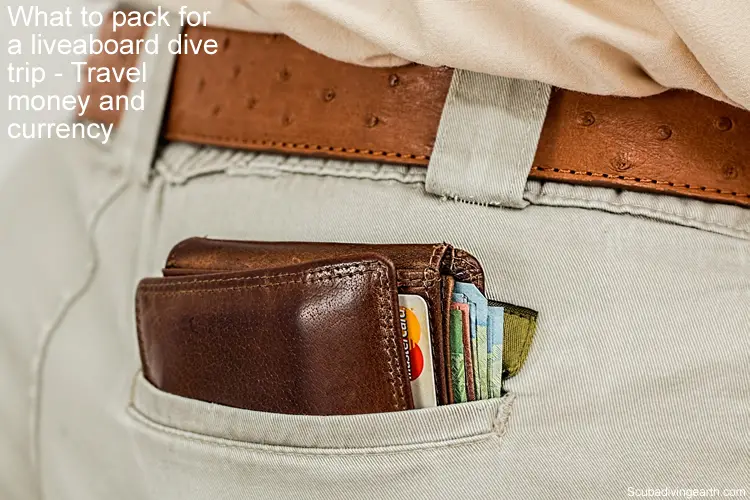
Whilst you’ll be on the liveaboard boat for the majority of your trip, you may need some local currency for your holiday. Local cash currency comes in handy in places like the airport and if needs be for transfers or taxis.
But also check with the liveaboard company what the extras are on board the boat. Find out how you can pay your final bill for drinks and other extras like internet connections and Nitrox.
Most liveaboard boats allow for payment by credit cards, but it’s best to check as some may need paying in local currency. This is quite often in US Dollars.
More Reading: What Does Liveaboard Mean? (What Is A Liveaboard Dive Boat?)
You’ll also find that your last day of your trip will be spent on land, whilst you wait to fly, which is usually on the following day. Whilst you can use your debit or credit cards for spending, having cash is always useful.
But also, many people like to tip the crew on a liveaboard boat at the end of the dive trip. Whilst this is not something you have to do, if you decide it’s what you want to do, this is much better done using cash.
More Reading: How long should you wait to fly after scuba diving? (What’s safe?)
3. Diving certification and log book
If you don’t take your diving certification you won’t be diving on your trip. However, most dive organisations are accessible online and if you have your details you’ll be able to be checked online by the dive master on the liveaboard.
But be sure to take the appropriate information to enable these details to be checked.
If you still like to log your dives, don’t forget to take your log book with you.
More Reading: Best budget liveaboards Egypt & The Red Sea (Affordable Red Sea diving)
4. Toiletries
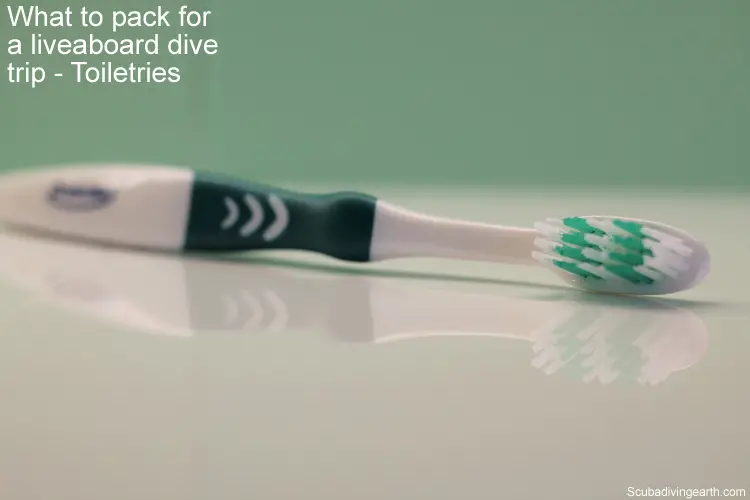
The basic essentials of any dive trip will include your toiletries, whether you’re on a liveaboard or not. But like many good hotels, many liveaboard dive boats already provide shampoo, soap and conditioner.
You’ll be diving at least two to three times per day, so your skin and hair may get a bit dry. So if you already use conditioner on your hair, you will need to make sure you use this every day on a liveaboard boat.
The other essentials include skin moisturiser and lip balm, as your skin and lips can get quite dry too. But make sure the lip balm you use has SPF protection from the sun’s rays.
More Reading: The 7 best budget liveaboards Komodo (Affordable Komodo diving)
Reef-safe sun screen
I’d also include in your toiletries sun screen or protection. But when using sun screen for diving, be mindful of the corals etc. Find a sun screen that’s safe for corals.
Whilst it’s important to protect yourself from the sun, please don’t forget to protect the coral from your sunscreen.
You should avoid sunscreens which have oxybenzone and other harmful chemicals as an ingredient. These chemicals can increase the chances of coral bleaching and over time may kill corals.
More Reading: The 9 best budget dive liveaboards Maldives (Cheap Luxury!)
5. Comfortable clothes appropriate for the climate

Staying on a liveaboard is not like staying on a resort or spending a week or so on a full-size cruise ship. You’ll not be going out for dinner or nights out on the town. You’ll be confined to the decks of the boat for the duration of your trip.
That means you are much better to pack your most comfortable clothes. But make sure you pack appropriately for the weather and climate. Most scuba divers are casual folk and no one really cares what you look like on these trips.
Therefore, always go for comfort over designer or fancy!
Depending on the destination, and assuming it’s somewhere warm or hot, pack light and include the likes of t-shirts and shorts, loose skirts and tops for the ladies.
It’s also a good idea to include at least one swim-suit cover up for wearing in between dives.
Pack light, as the cabins tend to be quite small and storage is a bit of a premium on liveaboard boats. But be mindful that the evenings can get chilly, especially out on the water, so a sweatshirt or two might also be a good idea.
More Reading: The best luxury dive liveaboard Galapagos (Dive in Luxury & Comfort)
6. Suitable footwear for onboard the boat
Possibly for the majority of your time spent on board will be in bare feet. This is especially true on a liveaboard located in a warm climate. But if you prefer to not be bare foot, a pair of flip flops (or thongs for the Aussies) will surfice.
But depending on the liveaboard trip, some offer land excursions. If this is the case, you may be advised to bring proper footwear for the excursion terrain. Once more check with your liveaboard company. But a pair of trainers may be enough for this purpose.
More Reading: What are the cheapest liveaboards great barrier reef (Diving on a budget)
7. Swimsuit

You decide on your swimsuit preference, assuming you’ve chosen a liveaboard in a warm climate. Bring at least two swimsuits to change each day.
Bring whatever swimsuit you’d normally wear under a wetsuit for diving.
More Reading: Do You Wear Anything Under A Wetsuit? (What To Wear Male & Female)
8. Exposure suit appropriate for the water temperature
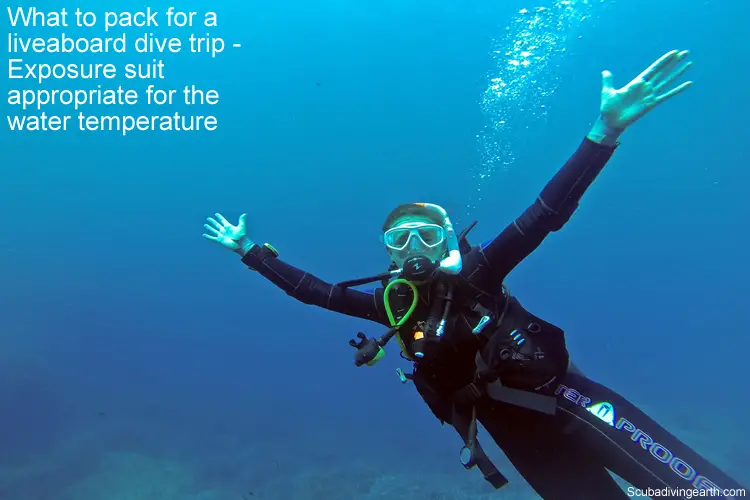
Before you embark on your liveaboard dive trip, make sure you check the water temperature for the time of year you’re visiting. The last thing you want to do is to feel cold when diving.
Just because you’re diving in a hot climate, doesn’t always mean the water temperature is equally as warm.
It’s extremely important to take the correct exposure suit for your trip. Otherwise your dives will be uncomfortable and you’ll use up more air keeping warm.
More Reading: 28 Tips To Conserve Air When Scuba Diving (How To Extend Your Dive Time Safely)
The liveaboard company you book with will be able to tell you the water temperature for the time of year you’re traveling. They will also be able to recommend the correct wetsuit thickness to wear.
If you tend to feel the cold, I’d go slightly thicker than they say. Remembering that many of the liveaboard dives tend to be long. Plus you’ll be diving multiple times per day.
If your trip warrants a drysuit, make sure you take the appropriate under garments to keep you warm. But make sure you’re familiar with the type of exposure suit necessary.
More Reading: Does a dry suit keep you dry (What are the exceptions & do you get wet)
Where necessary make sure you have the correct certification and experience in advance of your liveaboard trip.
More Reading: 5 best budget dive liveaboards Galapagos Islands (Affordable diving)
9. Underwater camera gear
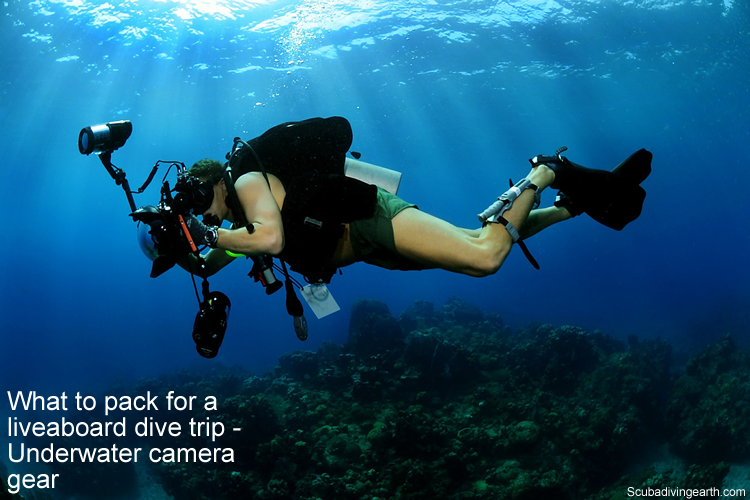
On a liveaboard dive boat you are so much more likely to see some fantastic sites both above and below the water.
More so than on a resort diving trip. Whether this is ship wrecks, sea life or underwater topography, there’ll be plenty to capture on a camera or by video.
Therefore make sure to bring your camera. But also make sure to pack any underwater housing to keep your camera water tight, extra batteries and plenty of memory cards.
More Reading: Bahamas Tiger Shark Diving Liveaboard (Tiger Beach Scuba Diving Safety)
10. Ear plugs for noise reduction
Most liveaboard boats travel at night when everyone’s asleep. That means the engines are running throughout the night. If you’re a light sleeper you may find it better to pack comfortable ear plugs.
More Reading: Scuba Diving Liveaboard Cocos Island Costa Rica (Diving with Hammerheads)
11. Medication including sea sickness prevention
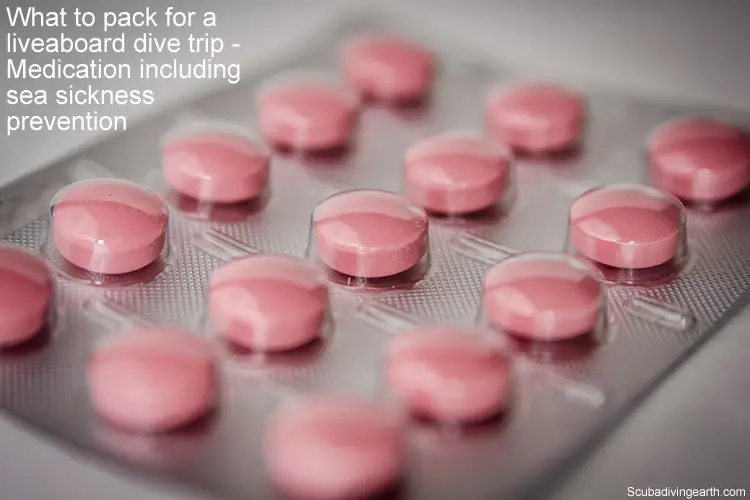
Depending on whether you’ve been on a liveaboard trip before, may decide on whether you take sea sickness medication with you or not. You may already know that you suffer from seasickness. If you do, make sure to include these in your essentials for your trip.
But just in case. it’s a good idea to pack some sea sickness medication in any case. You never know you may encounter choppy seas and this may catch you out.
If the night time travelling becomes rough, it’s a good idea to take seasickness tablets that will make you drowsy. This way you’ll get a good night sleep without getting sea sick and wake up refreshed ready for the next day’s diving.
More Reading: Jardines De La Reina Liveaboard (Best Cuba Scuba Diving)
12. Scuba diving equipment
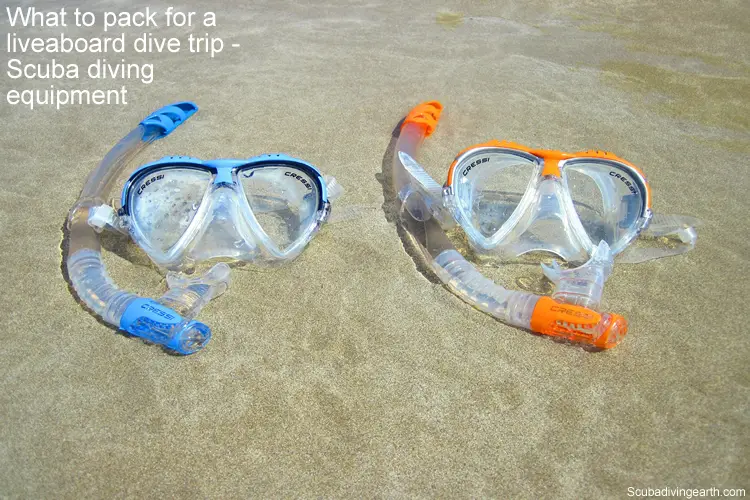
Whilst most liveaboards have equipment rental on board, you may wish to take some of your own scuba diving equipment yourself.
In any case, what I’d recommend is to take the following essential basics for any liveaboard trip:
- Dive computer.
- Torch for night diving.
- Mask and snorkel.
- Fins.
These are the basics for me, as I prefer to use my own mask and snorkel and if you’re used to your own fins, I recommend you take yours.
For me your own dive computer is a must have these days, so make sure you take this with you. But also take a torch, but if you don’t have one buy one. I find a torch is useful for both day-time and night diving. Torches are useful for lighting up crevices, wrecks and other areas to look for creatures etc.
More Reading: Why use a diving torch scuba diving (It’s not just for night diving)
In addition to the above list, I would also add my own regulators. I like to dive with my own regulator as I’m used to it and comfortable with the way it delivers the air underwater.
However, what you have to balance up is the weight of your baggage and what allowance your airline will afford you for your flight.
More Reading: Liveaboard Diving For Beginners (10 Top Liveaboard Destinations)
13. Sun glasses
Easily forgotten are your sun glasses. These are a liveaboard essential as you’ll not only have the sun glaring down on you from above, but you’ll also have the reflection from the water too. A sun double whammy!
More Reading: 9 Affordable Indonesian Raja Ampat Liveaboards (Budget Raja Ampat Diving)
14. Good book(s) to read or a kindle

Whilst most liveaboard boats have a book library on board, you are better to bring your own reading material. But if you prefer to read a Kindle, make sure you load it up with your books before you leave a free Wi-Fi and internet connection.
Whilst some liveaboards offer free internet, not all do and this could be expensive.
More Reading: Truk Lagoon Diving Liveaboard (Is the cost of a liveaboard necessary for Chuuk?)
I hope you enjoyed this article about what to pack for a liveaboard dive trip
I’d love to hear from you. Tell us about your adventures of diving and snorkeling, in the comments below. Please also share your photos. Either from your underwater cameras or videos from your waterproof Gopro’s!
If this article hasn’t answered all of your questions. If you have more questions either about snorkeling or scuba diving (or specifically about what to pack for a liveaboard dive trip), please comment below with your questions.
There will also be many more articles about scuba diving (and snorkeling) for you to read and learn about these fabulous sports.
Have fun and be safe!
More Reading: 10 Compelling Reasons Why Liveaboard Diving Holidays Are Popular
More Reading: Rowley Shoals Liveaboard Diving (How To Get To Rowley Shoals To Scuba Dive?)




